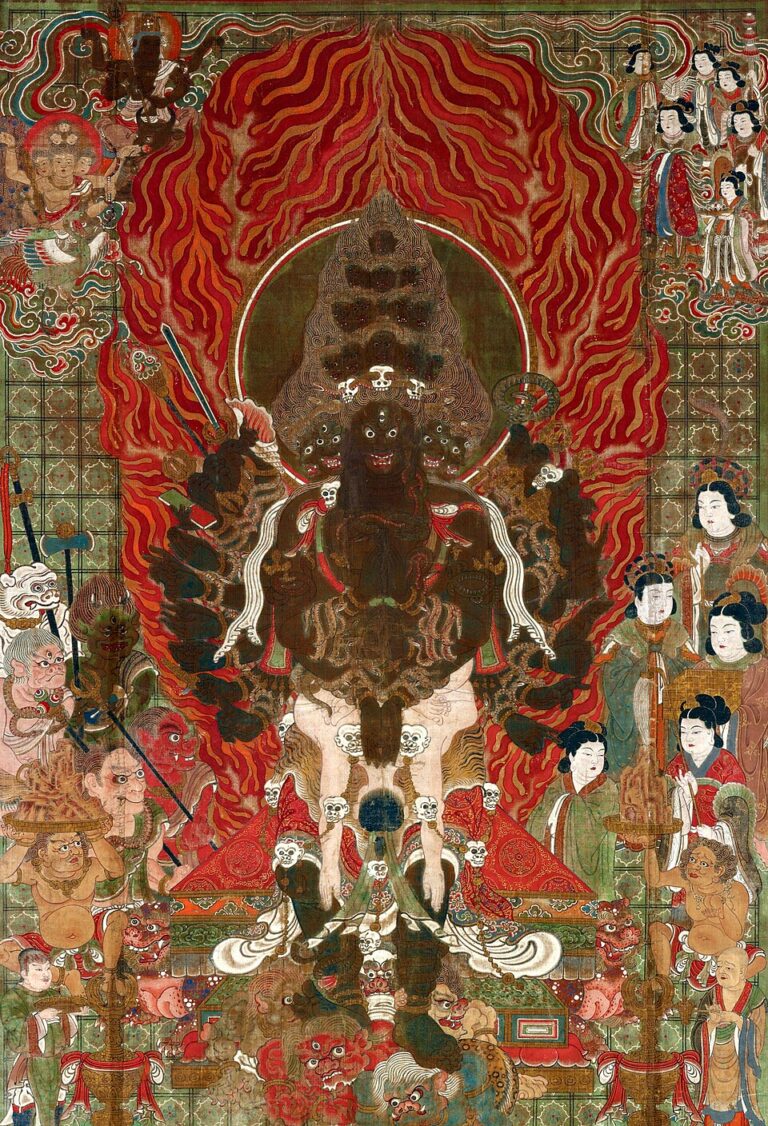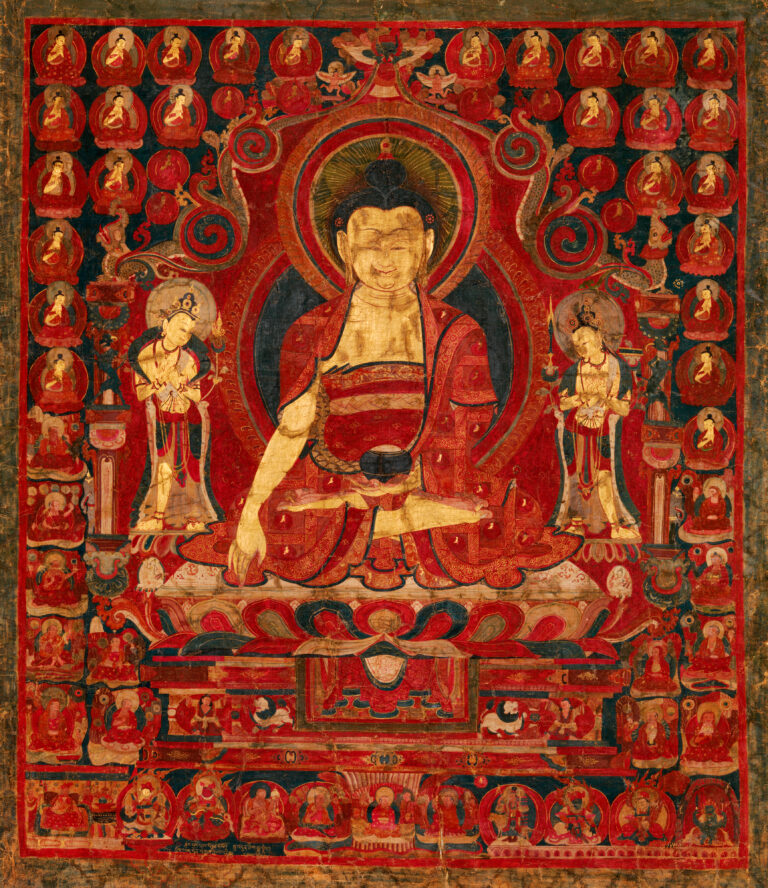“All the good works gathered in a thousand ages, such as deeds of generosity or offerings to the Buddhas—a single flash of anger shatters them.”
(Bodhicaryāvatāra 6.1)
Whenever we talk about love and the importance of training in compassion, a question that naturally arises—and quite frequently—is: What do we do when we’re triggered? Or, how can we remain compassionate when dealing with people who are aggressive, bitter, or arrogant?
At first glance, this might seem like a simple question. But it is, in fact, a very profound and essential one. Because it is relatively easy to practice compassion and empathy toward people we have a good relationship with—toward people who don’t upset or trigger us in any way. But as many of us know—especially those of us who genuinely try to live compassionate and peaceful lives—when a situation arises that triggers us (meaning it elicits some kind of survival response, such as aggression or defensiveness), then compassion becomes very difficult to maintain.
So the topic of this reflection is to explore the traditional methods—drawn from classical Buddhist and yogic sources—that are prescribed for maintaining compassion, for preserving bodhicitta (our inner sense of the wish for the well-being of others), even when faced with difficulty and adversity.
The First Practice: Restraint
The first and foremost thing we need to master in this regard is restraint. This is because, traditionally, it is said that when we “lose our cool,” when we allow ourselves to be pulled down into reactive states of aggression, vengeance, or judgment, especially when provoked by others, we not only suffer mentally—we also lose the merit we have accumulated. We lose the positive karmic momentum that has been built through our practice, through our sādhana.
At the core of this teaching is a very simple but powerful insight: a true practitioner—a yogi, a sādhaka—is not someone whose inner state is dictated by the behavior of others. That is the essence of spiritual strength. The defining trait of a yogi, especially in social situations, is that their behavior does not change in response to the negative actions of others. The core of etiquette, nobility, or dharma in action is that we maintain our integrity, even when those around us do not.
To cultivate this capacity, we must train in restraint. What does this mean in practical terms? It means developing the internal discipline to say to yourself, whenever you feel reactive—whenever someone has said or done something that upsets you or provokes you: “I will respond to this—but not now. I will give it five hours. Or better yet, I will respond tomorrow.”
This ability to pause is a powerful yogic tool. It allows the nervous system time to move out of a state of activation. It allows the mind time to settle so that your response can be appropriate and based on objective insight rather than compulsion.
So, the first practice we need to undertake is this: Whenever someone triggers you, give yourself a break before you react. Whether the emotion that arises is aggression, defensiveness, arrogance, or bitterness, delay your response. Let one night pass, if possible. Let your system digest the situation. Only then act—if it is still necessary to act.
The practice of restraint is not based on self-victimization. It does not mean we passively allow others to mistreat us or that we ignore harmful behavior. Rather, it is rooted in a profound wisdom: we ourselves are not always objective. We carry our own conditioning, our own traumas and biases, into every interaction. To perceive this clearly is an essential insight on the spiritual path.
When we recognize that our evaluation of a situation may be distorted or limited, we gain the humility to pause. This pause—the space between stimulus and response—is where wisdom can arise. It allows us to respond with clarity and compassion, rather than from compulsion or woundedness.
This is the foundation. If you wish to be a yogi, a sādhaka, a practitioner of the inner path, then your first obligation in this world is simple and profound: do not contribute to suffering.
This is the first tenet of Buddhism: non-violence.
It is the first practice of Yoga: ahimsa—non-harming.
Ahimsa paramo dharmaḥ—The highest religion is kindness.
This means that before you learn advanced meditation, before tantra, before mantra, before handstands and esoteric techniques—you must first learn how not to harm. You must learn how to be a force of peace, not agitation. You must learn how to help dissolve suffering, not perpetuate it. That journey begins with restraint.
The Second Practice: Meditation on Causes and Conditions
Once restraint is sufficiently developed—meaning we can resist reacting impulsively when triggered—we can begin to cultivate a deeper understanding of others through the meditation on causes and conditions.
This is what we might call the “Level Two” practice.
When faced with hurtful behavior, our habitual mind immediately tells a story: This person did this to me. I am the victim of their aggression. Their actions caused my pain. But in Buddhist thought, this view is considered naïve. It misses the interdependent nature of reality.
Instead, we train ourselves to see behavior—ours and others’—as arising from causes and conditions. Just as a seed requires water, sun, and soil to grow, people’s actions arise from their upbringing, stress, pain, and context.
We reflect: Do I know everything that’s happening in this person’s life? Have they lost someone? Are they under pressure? Are they carrying wounds I cannot see?
We remember our own moments of stress—times when we snapped, acted out, or spoke unkindly.
Then we ask: In those moments, did I receive grace? Was I met with forgiveness or understanding?
This is not just emotional—it is an intellectual and imaginative exercise.
It is the work of empathy, and empathy is not something that simply appears in us like a divine gift. Empathy is cultivated. It is trained. And its root is the ability to exchange self and other—to mentally step into the shoes of another being.
Reflect deeply on the times you caused harm to others—not maliciously, but due to being overwhelmed, hurt, or afraid. Bring to mind the people who met you with largeness of heart, with gentleness, even when you “did not deserve it” (even though, in truth, that concept doesn’t ultimately hold). Feel the truth of those moments, the grace of them. Let that remembrance soften your mind.
This is how you train empathy—not sentimentally, but rigorously. Through memory, analysis, and imagination.
Empathy becomes the safeguard. It is what allows us to meet violence without becoming violent, arrogance without becoming arrogant.
And this is essential, because if we react violently to violence, we break the flow of merit we’ve accumulated. We lose the sacred momentum of our practice. Our sādhana is diluted by reactivity.
So remember this: empathy is not weakness. Empathy is what protects your peace, your dignity, and your spiritual progress. And empathy is a skill—a cultivated, honed, and fiercely compassionate way of perceiving the world.
The Third Practice: Welcoming the Enemy as Teacher
The last and most advanced stage of this training—the third level—is also the most difficult to master, as it demands time, strength, and deep maturity. It is the practice of seeing those who challenge us—our “enemies”—as our greatest spiritual benefactors.
This is a radical view, but one that lies at the heart of classical Tibetan mind-training (lojong) and advanced yogic discipline. The teaching is simple but powerful:
Place the harm-doer as a guru on the crown of your head.
Why? Because friends and well-wishers—those who primarily evoke positive emotions in us—do not challenge our ego. They do not stretch us. They do not expose our reactivity or force us to confront the shadow parts of ourselves.
True spiritual growth only occurs when we are pushed beyond our comfort zones—when we are forced to respond to situations that we have not yet mastered. As long as we are only reacting to pleasant stimuli, we remain where we are.
So this third level of the practice is about welcoming difficulty as a rare opportunity for transformation. It means recognizing that every encounter with a difficult person is a test of our ability to actualize our practice. If we can meet their behavior with patience, empathy, and unwavering compassion, we purify vast amounts of negative karma. We evolve.
In fact, the hallmark of one who has succeeded in yoga, in sādhana, in meditation, is not how they sit or chant or perform asanas—it is how they respond in the face of adversity.
The true yogi is the one who stays peaceful and loving when challenged.
So this third level of practice is the most noble: to see the one who triggers us as a hidden guru, offering us the most precious gift of all—the chance to embody our values, our insight, and our compassion in real time.
Summary: The Three Levels of Response to Being Triggered
These are the three pillars of this spiritual training. Every time we feel the urge to react with aggression, retaliation, or harsh words—every time we want to “put someone in their place”—we can return to these teachings:
-
Restraint
Pause before you act. Recognize that you may not be seeing clearly. Allow space for the nervous system to settle, for clarity to emerge. Respond only after you’ve had time to digest the situation.
-
Empathy
Reflect on causes and conditions. Practice exchanging self and other. Remember times when you yourself acted poorly due to stress or pain, and were met with grace. Extend that grace to others. Train your imagination to dissolve the walls of separation.
-
Welcoming the Challenge as Teacher
View those who cause discomfort not as enemies, but as spiritual allies. They are the fire in which your compassion is tested and strengthened. They reveal how far your practice has come—and how far it can still go.
“Thus the patient person, full of strength,
Having gained this enemy for a helper,
Should cultivate the wish that all may find
Such helpful enemies to practice with.”
(Bodhicharyavatara 6.107)





